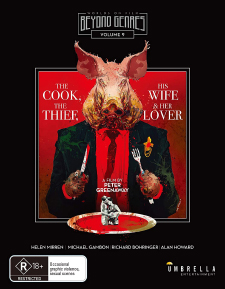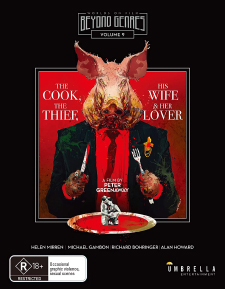Cook, the Thief, His Wife & Her Lover, The (Blu-ray Review)

Director
Peter GreenawayRelease Date(s)
1989 (April 7, 2021)Studio(s)
Miramax Films (Umbrella Entertainment)- Film/Program Grade: A
- Video Grade: B
- Audio Grade: A-
- Extras Grade: B+
Review
[Editor’s Note: This is a Region-Free release, NOT Region B as stated on the packaging.]
Thanks to a clash with the MPAA, director Peter Greenaway became something of a cause célèbre with the release of his 1989 film The Cook, the Thief, His Wife & Her Lover. Distributor Mirimax Films opted to release it unrated rather than deal with the dreaded “X” rating since they lacked the clout of a major studio like Universal, which was able to push the creation of the NC-17 rating the following year for Henry & June. As a result of the controversy, the film did a bit more business than any other Greenaway project before or since. In a strange way, it’s arguably one of his most accessible films since it operates on such a visceral level; while it has as many formalistic layers as anything else that he’s directed, the frequently repellent imagery can be apprehended instinctively rather than intellectually. But that’s entirely fitting for The Cook, the Thief, His Wife & Her Lover, since it repeatedly contrasts the intellect with literal viscera.
The story may be the least important element of the film. Boorish gangster Albert Spica (Michael Gambon) spends his evenings at a French restaurant run by Richard Boarst (Richard Bohringer), accompanied by his far more refined wife Georgina (Helen Mirren). When Georgina catches the eye of reticent bookseller Michael (Alan Howard), an inevitable chain of violence follows, culminating with some appropriately just desserts. Greenaway said that the narrative was inspired by John Ford’s Jacobean play ‘Tis a Pity She’s a Whore, but it’s really just a framework on which to hang his metaphorical and allegorical conceits. Greenaway’s real target was the runaway consumerism of Thatcher-era Great Britain, as he explained at the time: “Since this is a movie about consumer society, it’s about greed—a society’s, a man’s. A man who knows the price of everything and the value of nothing.”
Greenaway’s formalism is manifested from the opening shot of the film—The Cook, the Thief, His Wife & Her Lover doesn’t break the fourth wall, because no such barrier exists here in the first place. The sets are overtly theatrical, with carefully color-coded production design and costuming (the latter by none other than Jean-Paul Gaultier). Sascha Vierny’s extraordinary cinematography and Michael Nyman’s minimalistic score both help to tie everything together. Greenway fills the frame with a myriad of references, allusions, and even the occasional visual or verbal pun. He cheekily allows Flemish painter Hans Ral’s The Banquet of the Officers of the St George Militia Company in 1616 to dominate the central dining room of the restaurant, without explaining that Ral painted the members of the same company in 1627 and 1639 while wearing different colored sashes—an obscure reference which explains what happens to the sashes worn by Spica’s gang as they move from room to room. Even Albert’s name uses wordplay to conceal an ironic reference: “Spica” is an anagram of “aspic,” and aside from the gastronomic reference, there’s also no dandy in this particular aspic. For a film that throws such an abundance of blood, bodily fluids, and rotting flesh at the screen, nothing can be taken at face value.
The cast is superb, and while neither Gambon nor Mirren were Greenaway’s first choices for their roles, it’s difficult to imagine the film working with anyone else to anchor it. (Greenaway originally wanted Albert Finney and Georgina Hale, with Gambon playing the bookseller.) The supporting cast is equally good, including Tim Roth and a barely recognizable Ciaran Hinds as members of Spica’s gang. But The Cook, the Thief, His Wife & Her Lover is a director’s film from the first frame to the last. It took many talented individuals to help Greenaway bring his vision to the screen, but that vision is still unmistakably Greenaway’s.
Sasha Vierny shot The Cook, the Thief, His Wife & Her Lover on 35 mm film using Technovision cameras and anamorphic lenses, framed at 2.39:1 for its theatrical release. There’s no information about the elements provided to Umbrella Entertainment for this Blu-ray release, but it’s an older master with strengths and weaknesses. There’s light black speckling and minor scratches throughout the film, which are most visible against the white of the bathrooms or the static backgrounds of the menu cards. But that also means that there’s been no global application of noise reduction or other digital manipulation, so the image is fairly detailed and the grain is intact. The meticulously designed color scheme is well-represented, with good contrast and black levels—there’s perhaps some lost detail in the darkest areas of the screen, but this is a film where the shadows have always been dark. While a fresh scan or some frame-by-frame cleanup would have been nice, it’s still a fine presentation of the film.
Audio is offered in English 2.0 DTS-HD Master Audio with optional English subtitles. This is the original theatrical Dolby Stereo matrixed four-channel mix, and it has a nice sense of spaciousness when decoded. The surrounds are primarily used for ambience, but they make the large spaces such as the kitchen feel truly cavernous—it’s still an immersive mix, even with limited directional effects. The dialogue is clear, and Michael Nyman’s classic score sounds superb.
Umbrella Entertainment’s Blu-ray is Volume 9 in their Worlds on Film: Beyond Genres line, and it includes a slipcover as well as a two-sided insert for the keep case, both featuring new artwork by Simon Sherry. Interestingly, all of the text is on the slipcover only, with nothing but artwork on both sides of the insert—so don’t lose the slipcover! While the disc is identified as Region B-locked on both the slipcover and Umbrella’s website, it’s actually Region-Free. There’s also a single extra on the disc:
- Peter Greenaway: A Documentary (HD – 62:38)
The documentary features interviews, seminars, and exhibits with Greenaway in Germany and Holland between 1991 and 1992, so it covers his output through Prospero’s Books. It’s divided into eight chapters related to various aspects of his films, artwork, and philosophy. It opens with his complete short subject Revolution, and closes with the full short A Walk Through Prospero’s Library. In between, it shows him discussing his works, and it also provides behind-the-scenes footage of him shooting his Darwin episode for the television series L'encyclopedie audio-visuelle. Refreshingly, he’s not afraid to provide clear interpretations of his films, though not necessarily answers to all possible questions—he notes that he doesn’t take himself too seriously, and his films are filled with irony, paradoxes, and contradictions, so their endings don’t necessarily offer solutions. He feels that film shouldn’t be carried by narrative alone; there should be something else as well in order to structure and organize the material. For Greenaway, realism is a chimera which can’t exist for film, so he wants to remind audiences that what they are watching is artifice. That’s why The Cook, The Thief, His Wife & Her Lover ends with curtains closing—he wants to remind people that they have been watching a performance. Overall, this is a great documentary for those wanting insights into how Greenaway thinks.
The Cook, the Thief, His Wife & Her Lover isn’t for all tastes, in both the literal and metaphorical senses of the term, as it’s filled with imagery both beautiful and unpleasant. Greenaway has a unique gift for making food appear both attractive and disgusting at the same time, and the film freely associates sex, death, and bodily functions—as Albert notes in his typically coarse fashion: “The pleasures are related because the naughty bits and the dirty bits are so close together that it just goes to show how eating and sex are related.” But for adventurous viewers, it’s an open text with limitless depths to explore.
- Stephen Bjork
(You can follow Stephen on Facebook at this link)

